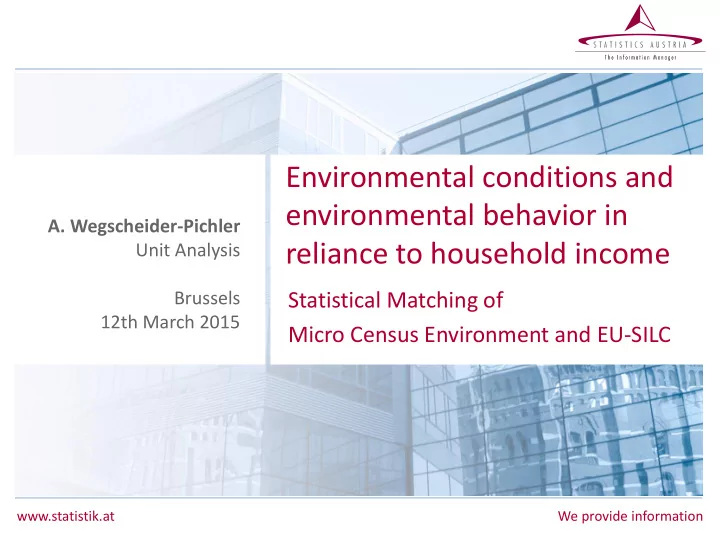

Environmental conditions and environmental behavior in A. Wegscheider-Pichler reliance to household income Unit Analysis Brussels Statistical Matching of 12th March 2015 Micro Census Environment and EU-SILC www.statistik.at We provide information
Starting Point (Surveys) Environmental conditions and behavior - is income a decisive factor? Micro Census “ Environmental conditions & behaviour ”: Data on quality of life, noise exposure, mobility… Micro Census “ Labour Force Survey (LFS )”: No income variable Socio-demographic variables like age, gender… + subsequently income of employed from administrative data! EU-SILC “ European Community Statistics on Income Income & Living Conditions ” www.statistik.at slide 2 | 11 March 2015
Project at Statistics Austria Connecting the Micro Census environmental data with income variables from EU-SILC through „ Statistical Matching “, using socio-demographic matching variables New information on environmental living conditions and environmental behaviour in dependence of income New insights into matching methodologies www.statistik.at slide 3 | 11 March 2015
Matching Process • Identifying relevant socio-demographic matching variables and harmonizing them in the data sets • Selection of a donor of minimal distance from EU-SILC for each micro census data case • In case of several donors with the same distance one was randomly chosen • Each EU-SILC data case was admitted only once as donor • 5 alternatives with different assumptions (weight, selected variable, household perspective) were calculated, best chosen www.statistik.at slide 4 | 11 March 2015
Chosen alternative (Detail) • Matching variables were weighted differently for the distance function • “ Income of employed ” was used for matching process • “Income of employed ” was considered from the household perspective , i.e. a total net income from all employed household members was aggregated www.statistik.at slide 5 | 11 March 2015
How to check validity? Micro Census LFS adds subsequently the variable “monthly income of employed” from registers Household-income can also be calculated by regression Possibilities to check the validity of the matched data: 1. Income of employed gained from data matching compared to LFS-income of employed 2. Total disposable household income gained from data matching compared to LFS-income of employed 3. Total disposable household income gained from data matching compared to Regression Household income (Micro Census) 4. Compare results with “expected outcomes” according to literature www.statistik.at slide 6 | 11 March 2015
Data check results 1. Data-Matching with use of the subsequently added variable “income of employed” improves on the individual level the correlation between EU- SILC “ income of employed ” & Micro Census “ income of employed ” from 0,63** to 0,97** 2. The household perspective increases the correlation between the EU- SILC “ total household income ” & Micro Census “ income of employed ” from 0,33** to 0,64** 3. Correlation (household perspective) between EU- SILC “ total household income ” & Micro Census “ total household income by regression ” gives a result of 0,72** ** Statistically significant at a level of 0.000 (Pearson). www.statistik.at slide 7 | 11 March 2015
Results - verifying the matching (Example) Quality of life by household income (terciles) 0.2 0.6 0.4 1.0 100 1.3 2.1 3.1 5.7 90 Bad 80 42.4 50.7 52.5 70 hare Not so 56.4 60 good ercentage S 50 Good 40 30 56.1 P Very 45.6 44.9 20 good 36.9 10 0 Total Low house- Medium house- High house- hold income hold income hold income S: Micro Census Environment; EU-SILC (2011) www.statistik.at slide 8 | 11 March 2015
Further descriptive outcomes Households with low income report higher disturbance by noise than households with high income Households with high income report more often to by organic food Public transport is less attractive for households with high income Households with low income use less often private transport (by car) as households with medium or high income www.statistik.at slide 9 | 11 March 2015
Findings for Statistical Matching Results of Data matching depend strongly on the selection and harmonization of the socio-demographic variables used for matching Variable "income of employed" significantly improved the matching process (for employed income is a substantial part of total household income) • → Data matching just on the basis of socio-demographic variables such as gender or age means to manage with correspondingly lower correlations than those in this study www.statistik.at slide 10 | 11 March 2015
Recommend
More recommend